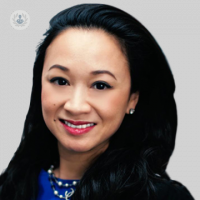Expert insight: Which minimally invasive techniques can be used to treat varicose veins?
Written in association with:Thanks to advances in recent years, there are currently a range of treatments for varicose veins which use minimally invasive techniques, ensuring excellent results and quick recovery time for patients. In this informative guide for patients, highly respected consultant vascular and endovascular surgeon Miss Nung Rudarakanchana sheds light on the most common minimally invasive techniques for varicose veins, including what each procedure entails. The revered specialist also discusses the price range of treatment of this type and associated safety and recovery factors.

Are there different types of minimally invasive techniques which treat varicose veins?
I offer patients three main minimally invasive techniques for varicose veins but the most common one I use is called endovenous ablation. In this technique, I put a needle into the vein under local anaesthetic and then pass a probe up inside the vein. The patient doesn’t feel this and I also give some more local anaesthetic to the tissues around the vein so that when I use the probe to heat the vein from the inside, there is no pain. The heat can be delivered either by a laser or radio frequency and causes the vein to block off. After between six weeks and three months following treatment, the body reabsorbs the vein and although the vein remains inside the body, the blood that was flowing the wrong way in the vein and causing the varicose veins is stopped, almost like turning off a leaking tap.
The second minimally invasive technique I use is foam sclerotherapy. It is a direct chemical injection into the lumps of the varicose veins themselves, with a detergent chemical that I mix with air. Using a very small needle, I inject the vein directly and this causes the vein to become blocked off. After a few weeks, the vein gets reabsorbed by the body and you no longer see the lumps at all.
Lastly, I also perform avulsions under a local anaesthetic, which is a more surgical procedure. This involves making very small cuts, less than a centimetre long, and hooking the lump or the vein out directly. This does leave very small scars but they heal very well and after six weeks to three months, you really don't see very much of them.
All of these techniques can be done under a local anaesthetic in day surgery, meaning you can walk in and walk out with very minimal recovery time.
Which technique is the safest?
All venous surgery techniques are very safe and the risks of any complications are extremely low. As with any type of procedure, however, there are some associated risks, the most significant being a deep venous thrombosis (a clot in the deep vein) following the surgery. Thankfully, the rates are very low, and in my own personal series, the rates are less than one in a thousand patients.
Most patients have no problems after minimally invasive venous surgery at all and I would call all of these minimally invasive techniques very safe.
Which is the most effective technique?
Most patients who I treat for varicose veins will require endovenous ablation and my preference is to use laser and then adjunctive treatment for the lumps or the varicose veins themselves in the form of sclerotherapy or avulsions. I tailor my treatment to each patient's needs.
Sclerotherapy does carry a small risk of skin staining, a brown discoloration of the skin, although for most people this does fade. If my patient's main concern is a very quick cosmetic recovery, then I might offer them avulsions as a way of removing the veins immediately.
Which is the most common minimally invasive treatment for varicose veins?
The most common minimally invasive technique I use is endovenous laser ablation, which is a technique that closes off the main truncal vein responsible for reflux.
Veins normally take blood from the feet back up to the heart - they are the return pipe. However, quite commonly (between one in three and one in four people), the valves in the veins aren't working as efficiently as they might, causing blood to spill back down towards the feet with gravity. Over time, the veins dilate, the valves become more inefficient and eventually varicose veins appear at the surface. These are the lumps that you can see at the surface.
In some people, complications can develop such as dryness or itchiness of the skin, venous eczema, swelling of the ankle, discomfort, tiredness, or restless legs. In a very small number of patients, these symptoms can eventually progress into ulceration or wounds in the legs that don't heal.
To correct the primary problem which is the feeding problem of the vein reflux itself, I use endovenous laser ablation. This is mostly performed under local anaesthetic by putting a needle into the vein and then passing up a probe on the inside of the vein to heat the vein up from the inside using a laser. This causes the vein to block off and stops the blood spinning down back towards the ankle.
In addition, we can use foam sclerotherapy or avulsions to treat the lumps themselves, so they are taken away immediately and the cosmetic appearance of the leg also improves.
Are the results of endovenous laser ablation permanent?
Endovenous laser ablation is a very effective technique. It has closure rates of about ninety-nine per cent in the initial phase and the recurrence rates (patients who come back with problems with their veins) are very low at around five per cent at five to ten years.
What is the price range for minimally invasive procedures with varicose veins?
The price of treatment ranges according to the size of the problem. For thread veins or reticular veins, I can offer micro sclerotherapy which costs a few hundred pounds. For patients who have very established varicose veins and venous disease, they may require endovenous laser ablation with foam sclerotherapy and potentially, a second session of foam sclerotherapy. This course of treatment can cost up to £3000.
How long does it take to recover following treatment of this type?
Using minimally invasive techniques, I can get patients back on their feet almost immediately after their procedure. All patients need to wear compression stockings for one week, but most people are able to get back to their normal exercise routine, such as running, HIIT (high intensity interval training) exercise, or playing tennis, after the first week.
If you are seeking treatment for varicose veins and wish to schedule a consultation with Miss Rudarakanchana, you can do so by visiting her Top Doctors profile.



